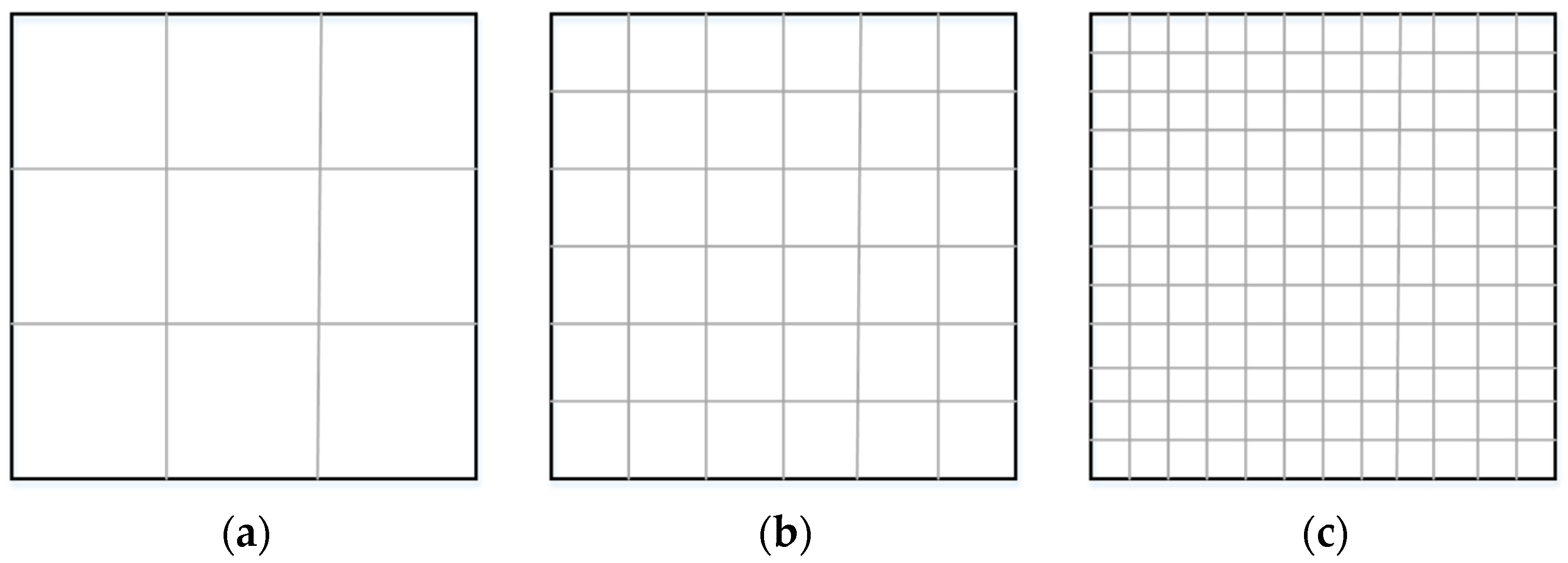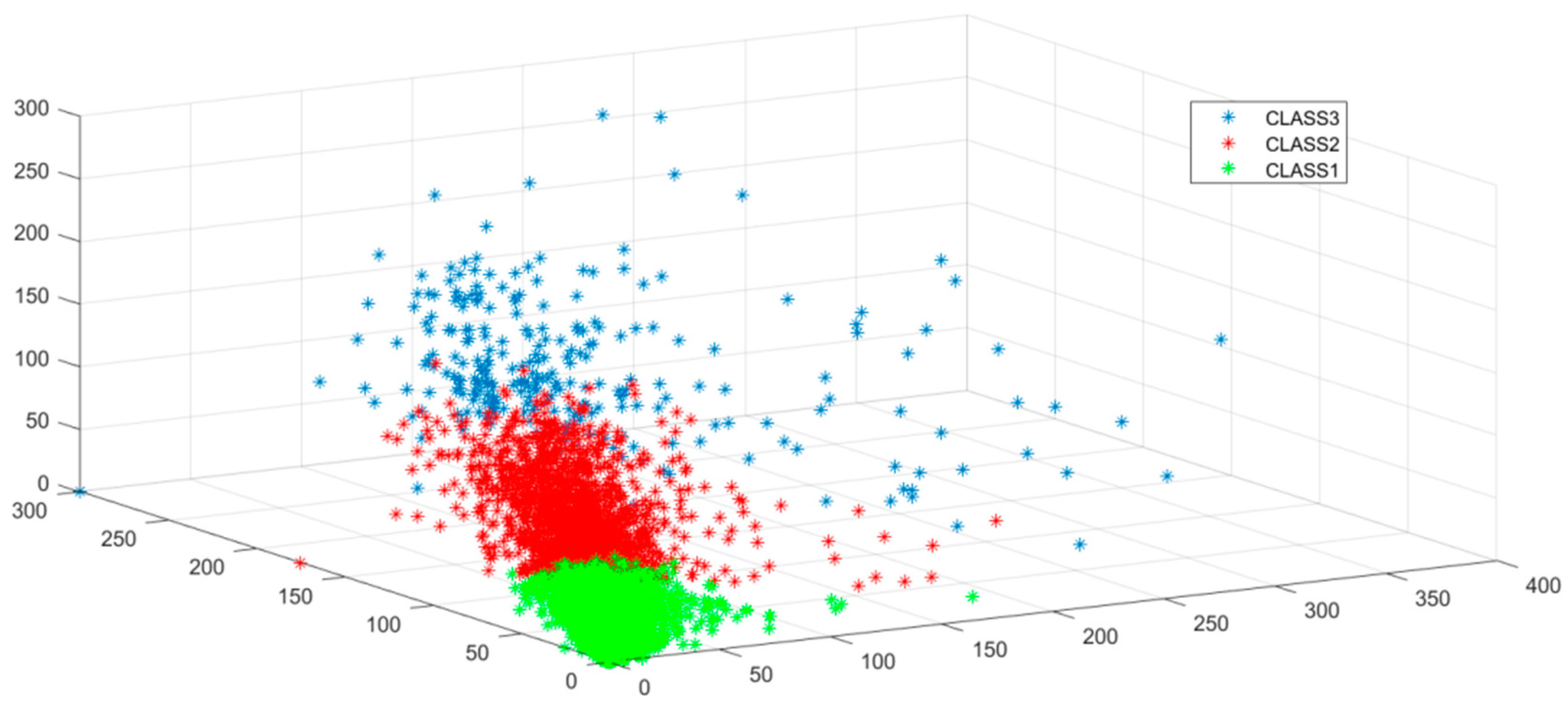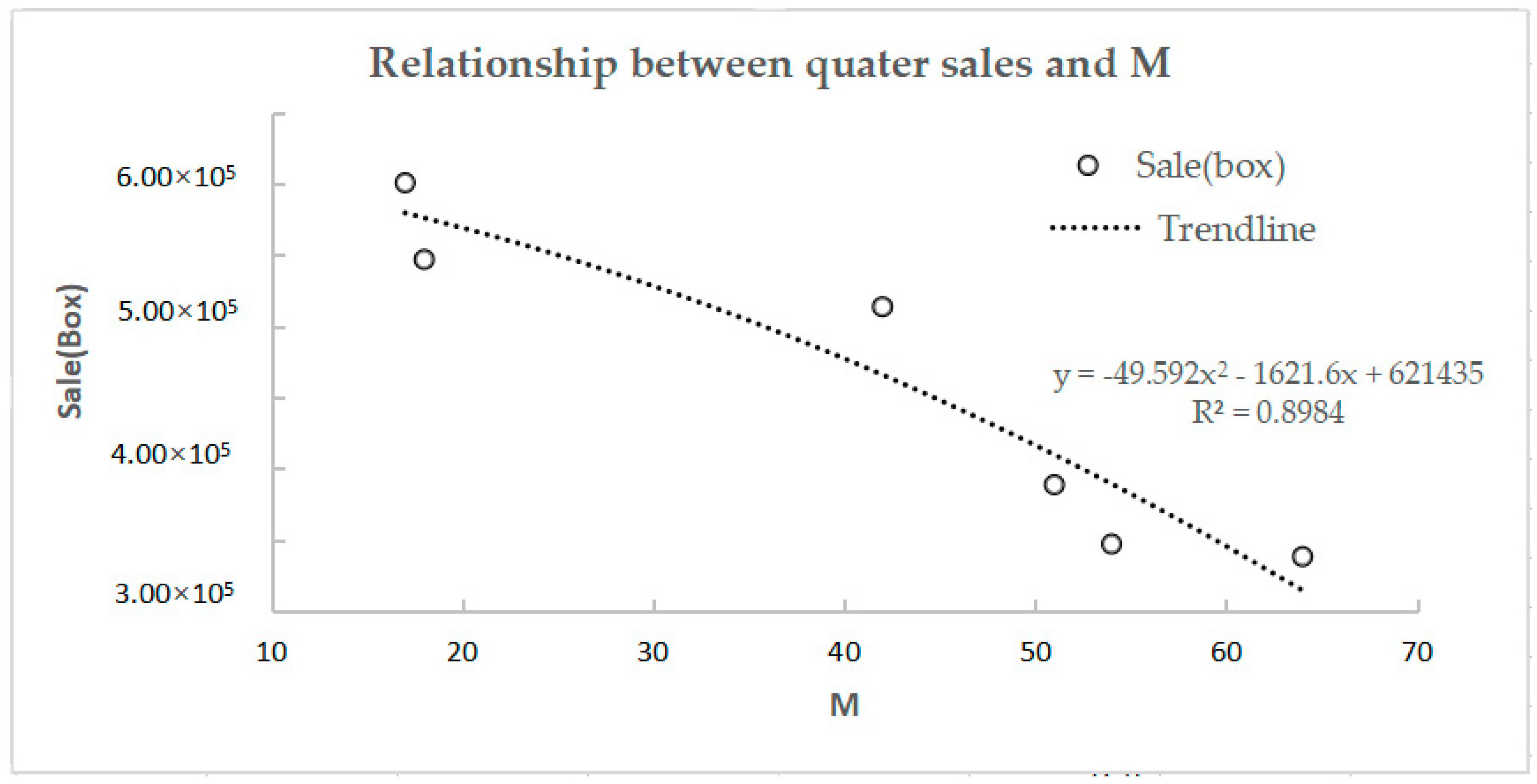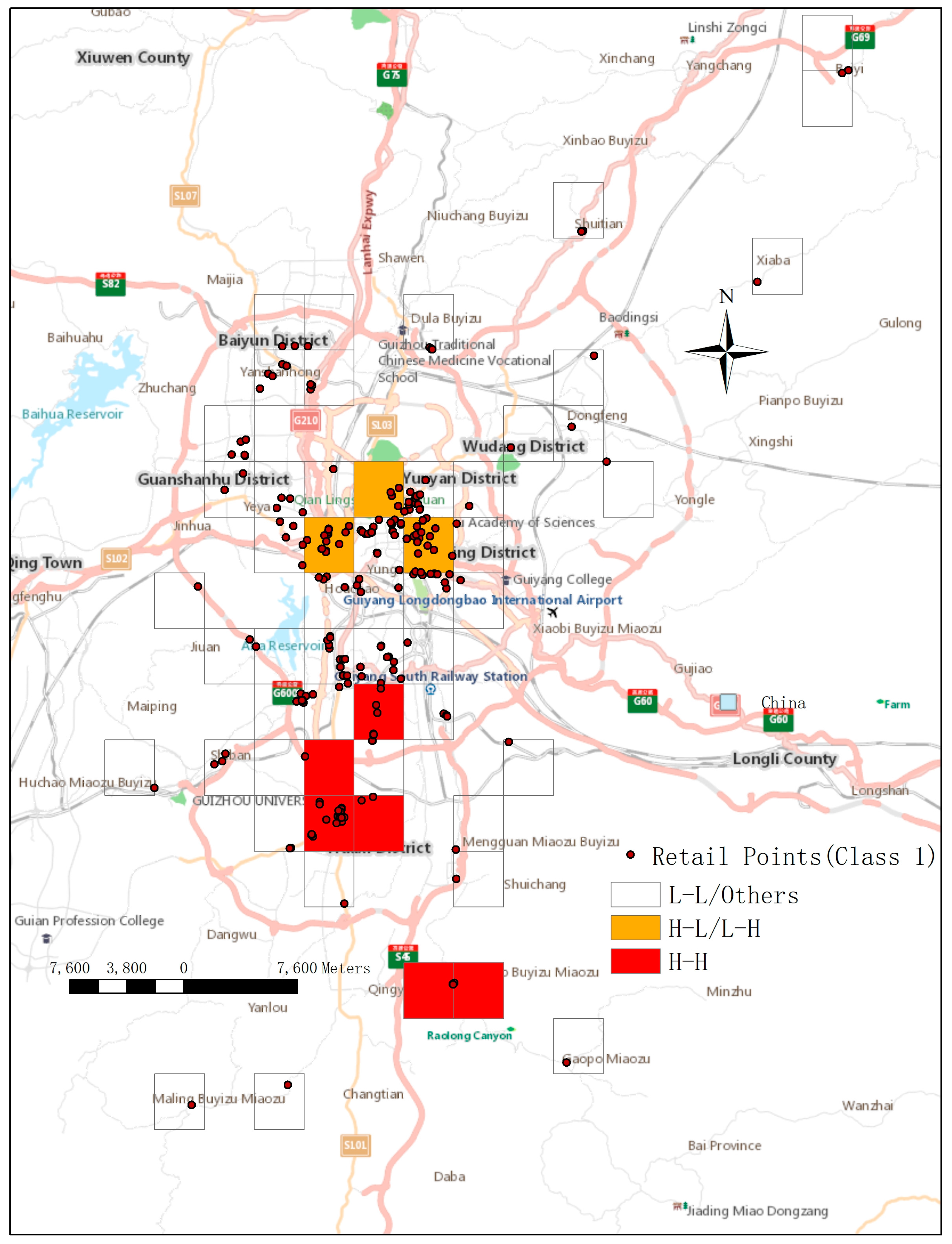5.1. Estimating Consumer Demand in Grids
Realistically, to increase profits, the distribution ratio must be maintained near the cluster centers from the results in
Section 3. The implementation of the principle however, is the main problem for retail shops, because the actual market demand exists great differences between areas or even nearby streets. For each store, their current distribution and ratio of products are different from the standard clustering center
X (
X1,
X2, and
X3). The difference may be small for some shops but may be large for other shops. If we blindly adjust the distribution strategy for every shop and dramatically shrunk the gap between the current ratio and standard clustering center, then this approach will definitely cause a bust in the sales of products, thereby causing the risk of profit losses to the shops. Thus, the precise marketing strategy will be based on spatial auto correlation algorithm.
We took first class shops as experimental objects. The analysis of the other two classes of shops was similar. The 453 shops grouped in the first class were distributed in several areas of Guiyang. For every shop, there was variance M, describing the gap between its current ratio and the standardized ratio. We selected shops with small M values and large spatial aggregation values. We could decrease the gap between these shops to a large degree and decrease the gaps of shops whose M values were high by a small degree, by changing their distribution strategy.
Spatial correlation is an important research method in spatial statistical analysis; it is used to explore the degree of influence between regions. In spatial auto correlation analysis, a hot region usually occupies a place with relatively high values; retailers in hot regions are close to each other. However, in our data set, the
M value of shops with high sales is relatively small. Thus, to satisfy the assumptions for auto correction analysis, we use a reciprocal variance to represent the gap between current products ratio and standard ratio. We use
to represent the reciprocal variance; the formula is as follows, in which
represents the average gap of the 6 quarters. The consumer demand in grid cells with large
is higher than the grid cells with small
:
We used spatial auto correlation analysis based on the of first-class shops. This result was then used to determine an appropriate distribution optimization strategy for each retail shop. We use two methods of analysis. First, we directly conducted spatial auto correlation analysis for shop points. Second, we conducted spatial auto correlation analysis based on the spatial segmentation model, in this case for grid cells.
We created a scatter plot for
and mean sales, based on which we established the functional relationship between the
and mean sales using maximum likelihood estimation. The results are shown in
Figure 5.
Figure 5 shows there exists high correlation between
and sales in each grid cell, with the high
R2 value 0.733.
Table 3 shows the effects of the grid-based spatial division method we adopted. We compared the
R2 calculated by the retailers and by grid cells.
Table 3 indicates that using the grid as a geographical unit is better than merely using single retailers, with lager
R2. The sales model can provide support for planning the distribution strategies of shops that belong to the same grid. The model can also predict sales in each grid based on their variance.
Our goal is to improve the total sales by grid cells and adjust the distribution strategy of shops whose current sales situation is not favorable, thereby improving their profit and satisfying consumer demands at the same time. Our research provides an efficient method to do so. We used a spatial auto correlation method based on the
of first-class grids to find out different patterns of market demand in different grids.
Figure 6 shows the spatial auto correlation results for shops that belong to class 1.
Figure 6 shows the auto correction results, and the grids are distinguished into 3 colors. The red regions were areas in which market demand was “high–high” aggregations. The purchasing strategies of shops in these regions were generally close to the clustering center, indicating the consumer demand was relatively high and stable in these places. Thus, we can optimize the purchasing strategies of the shops located in these areas whose purchasing ratio does not match the market demand. This adjustment will bring their purchasing ratio closer to the clustering center. This approach will effectively improve their sales. For the retailers located in orange areas, the market demand is “high–low” or “low–high” aggregation, which means the market demand of nearby grids existed large difference with the grid. The market demand of the orange areas was lower than the red areas, but higher than the transparent areas. The distribution strategies of these shops can be adjusted slightly, and the focus can be on improving the shops whose
values are below the average level in their grid. For retail shops located in the transparent grid, their market demand was ‘low–low’ aggregating or other situations. Thus, their statuses could be retained, or fine adjustments can be applied.
Table 4 shows the shop numbers and average
M* in grids of 3 colors.
From
Table 4, we can see the shop number,
value in the grid cells of three colors. There were 75 retailers in the red regions, and the average
value of the retailers was 5.9.There were 141 retailers in the orange regions, the average
value of the retailers was 8.6.There were 237 retailers in the Transparent regions, and the average
value of the retailers was 12.1.The variety of
values means the consumer demand exists differences to the retailers in the grids of 3 colors, which indicate that the optimizing strategies should be taken according to the differences of consumer demand.
In order to verify if the grids can effectively reflect the consumer demand in different areas, we used Gauss test to find the sales situation in different colors of grids. We randomly chose 50 retailers in each color of grids, and used
R studio to calculate the
P-value of them, the results were shown in
Figure 7.
The benefits of this method include two parts: Firstly, the consumer demand of each grid can be estimated with the , which will present more microscopic information of consumer demand for retailers. Secondly, the method can provide information about which kinds of adjustment strategies should be taken for retailers based on the colors of grids they belong to. That means not every retailer should adjust their purchasing strategies to the maximum market demand, the strategies should be considered according to their locations to avoid bust of sales, the thought of which a reflect of sustainable concept.
5.2. Optimized Purchasing Strategies
To obtain the sales situation in grids with different colors, we selected 10 shops in the red area and 10 shops in the orange area. We divided the shops into two groups according to their colors of grids. These two groups of retailers both belong to the First Class. The sales situation shown in
Table 5.
Table 5 shows that the average sales of shops in group1 were larger than group2, while the
values of shops in group1 were smaller than group2.This indicates that the consumer demand in group1 was larger than group2. In order to improve the regional sales and avoid sales bust, we need to adjust
values in the right way.
In this paper, we implemented specific adjustments to purchasing strategies. The first was a positive strategy. The positive strategies were recommended to retail shops that satisfied two conditions. The first condition was the average sales of the region were very high. The second condition was that there existed high spatial autocorrelation between the sales of the region and its nearby regions. That indicated the consumer demand around these shops was relatively high and stable, so that the purchasing strategies of retail shops that did not sale well could be adjusted closer to the average level to get more profit. In this strategy, the
values of the shops of Group1 below average value would be adjusted to the average value
_1. The second strategy was a conservative strategy that could raise the
value to
_2, the average value of the current
value for each shop and the average
value of all retailers in group1. The conservative strategies were recommended to retail shops with middling sales performance and lower spatial autocorrelation between regions. These retail shops mainly distributed not far from the city centers. The main purpose of the strategy was to adjust the sales strategies based on their current sales performance. The strategies could ensure the stability of their sales performance, and bring small increase of profit for them. The
_1 and
_2 values are calculated as following:
Table 6 indicates the effect of these two strategies on sales. The predicted sales for each product was also calculated. The best percentage can be confirmed by the sales performance.
The
Table 6 shows the influence of the two strategies on retailers in red areas and orange areas, respectively. For the 10 retailers in red regions with ID between G1.1 to G1.10, the sales situation was much better than the retailers in other regions with the average sales reaching 340, and the auto-correction of them were also relatively higher. That indicated that market demand of red regions was the highest among all regions, and the low average
M* value 5.07 also indicated the stability of the market demand. Based on the above reasons, the positive strategy could be adopted to improve the sales of retailers in the red regions. The average
M* value 5.07 was used to estimate the market demand quantity, which was 356, based on the formula in
Table 3 (y = −0.0032x
6 + 0.1162x
5 − 1.5471x
4 + 9.8235x
3 − 35.369x
2 + 55.349x + 391.65).
From
Table 6, we can see 5 retail shops, G1.3 G1.4 G1.5 G1.7 G1.10, the original sales of which were lower than 340, were suggested to improve the purchasing quantity to 356. The best purchasing ratio of three products (128,100,128) was also calculated based on the clustering analysis results. Then, the purchasing strategies of the 5 retail shops was adjusted to 128,100,128, in this way, the theoretical average sales of shops in the red regions could reach 362, which was improved by 6.4%.
To the 10 retailers in orange regions with ID between G2.1 to G2.10, the sales situation was more worse than the red regions, but better that the transparent regions. The average sales of them were 182 and the average value of them was 8.8, which indicated the market demand of these regions was not very stable as the red regions. The regions might be some places nearby the commercial centers, to the shops in these places, the conservative strategies were adopted to improve the sales in these places and avoid the bust at the same time. There were 5 retail shops, G2.2 G2.3 G2.4 G2.6 G2.8, the sales of which were lower than the average sales, so that the values of them were adjusted to be the average value of their current value and 8.8. The purpose of the strategy was to adjust the sales strategies based on their current sales performance. The theoretical sales were estimated based on the new values, and the purchasing ratio of three products was also calculated. The theoretical average sales could reach 200, which was improved by 9.8%.
To retailers in transparent regions, the average value was 12.1, which was larger than the red and orange regions, so that the market demand in these regions was nearly small and not stable. In this paper, we think the adoption of new purchasing strategies may be meaningless even would cause some bust of sales in these places, so that the retailers in these regions just need to keep their current purchasing strategies.
In the practical business, other optimizing strategies can also be considered based on the strategies we put out in this section. For instance, the value of the retailers in red regions with higher sales can also be adjusted to be closer to 0 to reach the maximum potential of market demand, which was based on the purchasing ability of retailers. The most important thing is that all the adjustment should be based on the locations of retailers and sales performance of the region and nearby regions, which was represented with different colors in this paper. It is an effective way to carry out practical strategies for every retailer.











